
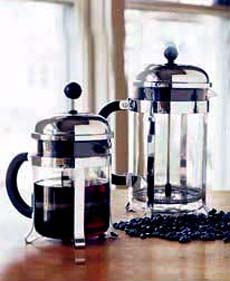 Many serious coffee drinkers prefer to brew their coffee in a French press. These French presses, by Bodum, are available at Sur La Table. Many serious coffee drinkers prefer to brew their coffee in a French press. These French presses, by Bodum, are available at Sur La Table.
July 2005
Last Updated August 2024
|
 |
Coffee Glossary
Page 2: Coffee Terms & Definitions Beginning With C
Study these terms and you’ll have a much greater appreciation of that next sip of coffee. Practice the language of coffee by using these terms to describe each cup you drink. Soon, they’ll become natural to you—and you’ll be able to educate others. This is Page 2 of a six-page Coffee Glossary. For terms specific to espresso, see our separate Espresso Glossary. Take a look at our many food glossaries, covering your other favorite foods.
Click on a letter to go to the appropriate glossary page:
a b c d e f g h i j k l m n o p q r s t u v w x y z
This glossary is protected by copyright and cannot be reproduced in whole or part.
CAFÉ AND CAFFÈ
The French and Italian words, respectively, for both coffee, the drink, and coffee shop, the place where one can drink it.
CAFÉ AU LAIT (FRENCH) or CAFÉ MISTO (ITALIAN)
A brewed coffee beverage that’s half coffee and half steamed milk. It differs from white coffee, which is coffee with cold milk or other whiteners added, and from cappuccino, which is espresso topped with foamy steamed milk.
CAFÉ CANARIO
In Spain, a café solo topped with sweet, thick milk.
CAFÉ CON HIELO
A sweetened iced coffee served in Spain.
CAFÉ SOLO
The Spanish term for espresso. See our Espresso Glossary for more espresso definitions.
CAFFÈ
The Italian word for coffee or coffee shop. The French and Spanish word is café. The German word is Kaffee.
CAFFÈ AMERICANO
A single or double shot of espresso that’s poured over six ounces of fresh hot water to produce a milder (“American-style”) coffee. Unlike with American coffee, the crema should rise to the top of the finished beverage.
CAFFÈ BREVA
A cappuccino made with half and half, instead of whole milk.
CAFFEINE
A bitter alkaloid contained in coffee and tea that stimulates the central nervous system and, in the right amounts, causes adrenaline to be released. Caffeine can enhance heart function and is said to help with intellect. Too much caffeine can overstimulate and cause discomfort.
|
CAFFÈ CORRETTO
Caffè corretto is an alcoholic espresso, usually a shot of espresso with a small amount of grappa (brandy and sambuca are also used. It is ordered as “un caffè corretto alla grappa,” “... alla sambuca,” etc. Outside of Italy it can be called espresso corretto. Most Italian bartenders simply add a few drops of the desired spirit into an espresso shot; however, in some cases the spirit is served as a separate shot alongside the espresso, enabling the customer to pour the quantity desired. The term translates to “corrected” coffee. Why? According to some food historians, it creates a perfect union of grappa and coffee; thus, a “corrected” coffee. Others say that when tariffs on coffee went up in Fascist Italy, spirits were added to correct the taste of cheaper coffee substitutes. Here’s the history of caffè corretto.
|
|
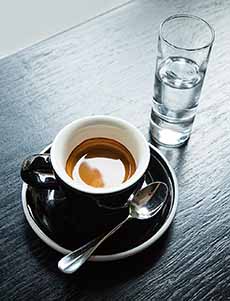
A caffè corretto is espresso with added spirits or with a shot on the side (photo © Punch Drink). |
|
CAFFÈ LATTE
A coffee drink made with a double shot of espresso topped with steamed milk and finished with a quarter-inch of steamed milk foam. The milk is poured down the side of the cup to cause the two liquids to swirl together, creating an almost marbleized appearance. A caffè latte is much milkier and creamier than a cappuccino, made with one part espresso and at least five parts of steamed milk, with only a small amount of froth on top. Cappuccino is made in equal parts of espresso, steamed milk, and foam. Latte “art,” creating designs in the steamed milk, has become very popular, with international competitions held for baristas. See our Espresso Glossary for more espresso definitions.
|
|
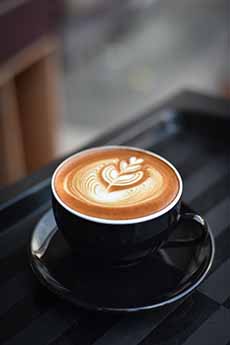
A caffè latte with foam art (photo © Chevanon Photography | Pexels). |
|
CAFFÈ LATTE FREDDO
An iced caffè latte is an espresso mixed with cold milk in the same proportions as a caffè latte and shaken vigorously with ice in a cocktail mixer. See our Espresso Glossary for more espresso definitions.
A caffe latte freddo can also be made with matcha green tea, creating an iced matcha latte (in the photo at right).
CAFFÈ MACCHIATO
Steamed milk with a shot of espresso. The ratio of coffee to milk is approximately 4:1, as opposed to a latte, which is 3:1 and topped with steamed milk foam.
|
|
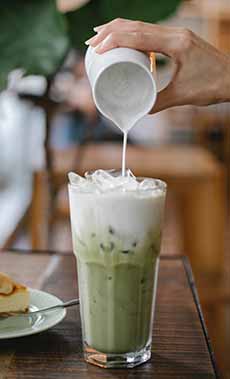
A caffè latte with foam art. Photo courtesy SXC. |
CAFFÈ MOCHA
An espresso-based drink that combines one shot of espresso, an ounce of chocolate syrup, and frothed milk, topped with whipped cream and sprinkled with cocoa. Some people add the chocolate syrup to the milk before steaming to produce a chocolate froth. See our Espresso Glossary for more espresso definitions.
|
CAPPUCCINO
A beverage made from one or two shots of espresso, topped with equal parts of steamed milk and steamed milk foam. Many people enjoy a sprinkling of cinnamon on top. See our Espresso Glossary for more espresso definitions.
Photo by Laura Kennedy | SXC.
CARAMEL
A flavor and aroma in some coffee that is evocative of caramel.
CHEMICAL
An off aroma and/or flavor evocative of chemicals; or coffee tainted with chemicals. It can also be described as medicinal.
|
|
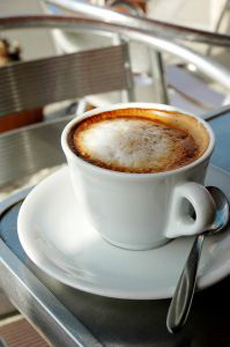
Cappuccino. Photo by Mac Pale | SXC. |
CHICORY
A plant root that’s roasted and used as a coffee filler in coffee that’s popular in New Orleans.
CHOCOLATY
A flavor and aroma characteristic of many coffees.
CINNAMON ROAST
A light roast. Cinnamon is the darkest of the light roasts, which also include Finnish and Scandinavian roasts. The next darker roast is known as an American Roast.
CLARITY
Descriptive of the most refined coffee, with acidity, balance, and a clean finish.
CLEAN
A well-graded coffee, free of defects. After coffee cherries are harvested, they are taken to a washing station. To create a top-grade coffee, the defective or bruised cherries are removed. This will produce a cleaner-tasting coffee with a crisp finish.
COCOA
A coffee with the natural aroma and flavor of cocoa powder.
|
COFFEE
Coffee is the common name for seeds produced by shrubs of the Coffea gender of the family of the rubiaceas. The word comes from the Turkish kahveh (read the history of coffee to see the important part Turkey played in its evolution.) The plant grows worldwide in volcanic soil in tropical and subtropical climates between the Tropic of Cancer and the Tropic of Capricorn, a 25-degree latitude belt on both sides of the equator.
|
|
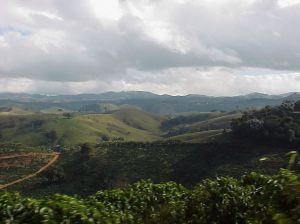
Coffee plantation. Photo by Ana Labate | SXC. |
It grows, from sea level up to 6,000 feet, but the best coffee arabica grows around 5,000 feet. The tree doesn’t like heat greater than 90°F, and frost will kill the coffee plant. Among the 30 or so species included in the Coffea gender, only three produce quality coffees: Coffea arabica and Coffea canephora, known as Robusta. A third variety, Coffea liberica, produces coffee in marginal quantities. There are varieties grown indoors as household plants because the coffee plant can do well there. Some varieties of coffee plants typically grow over 30 feet. But, in cultivation, for ease of picking the coffee berry, the plant is seldom allowed to grow over 15 feet. The Arabica plant is typically smaller than the Robusta plant and is a tree-type plant with a straight-up trunk with branches paired off outwardly. Coffea robusta is a shrub-type plant that grows similarly to a bush, in that it has several trunks. (about 80 countries grow coffee, 30% comes from Brazil and a second major exporter is Colombia)
COFFEE BEAN
Almost everyone is familiar with roasted coffee beans. The beans are actually the seeds of the fruit, or berry, of the coffee plant. The berries are picked, the pulp is removed, and the green seeds are roasted.
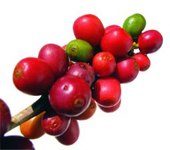 |
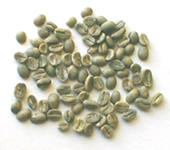 |
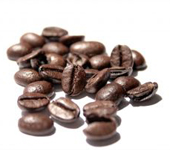 |
| Ripe Coffee Cherries |
Green Seeds (Beans) For Roasting |
Roasted Coffee Beans |
COFFEE CHERRY, BERRY, OR FRUIT
The fruit of the coffee plant, the cherry contains the seeds--the coffee beans. The cherries grow to about .5 inches to 1.25 inches in diameter, depending on the species. The cherries grow in clusters; when they are ripe, they turn bright red (see photo above, left); when they are past ripeness, they turn brown to reddish brown and fall off the branch. Some growers allow the cherries to fall to the ground, but most pick them when they are red.
|
COLD BREW COFFEE
Cold brew coffee, also called cold water extraction or cold pressing is made by steeping coarse-ground coffee beans in cold or room temperature water for 12 to 24 hours. This slow, low-temperature extraction makes cold brew taste more flavorful and less bitter. You can find more of the notes of the terroir of the beans: red fruits or chocolate, e.g.
Cold brew is just the brewing method; it can be served cold or hot. As an analogy, drip and pour over are two other brewing methods that can be served hot or cold.
|
|
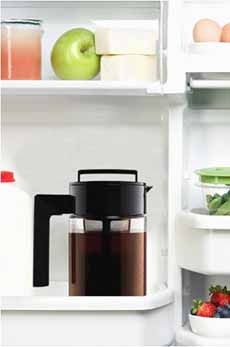
Cold brew in the fridge. It can be served hot or cold (photo © Takeya). |
COMPLEX
A taste or aroma with numerous characteristics; as opposed to simple, with just one or two. For example, a particular coffee can be chocolaty and smoky, flowery and fruity, or have several taste sensations that layer and evolve, as with fine wine. Coffees with such depth and resonance are considered to have complexity and to be more rare and valuable than those with single flavor and aroma notes. As in all foods, those with complex, layered flavors offer more depth and resonance and are considered more sophisticated and of higher quality.
CORTADO
A Spanish version of espresso mixed with a roughly equal amount of warm, steamed milk to reduce the acidity. The exact ratios can vary by region.
CRISP
Crisp refers to a clean coffee with bright acidity.
|
CREMA
Crema is the caramel-colored foam that appears on top of a shot of brewed espresso. The crema is due to colloids and lipids forced out into an emulsion under the pressure of an espresso machine and helps retain the aromatics and flavors of the espresso in the cup.
CUPPING
A technique of tasting by coffee professionals to assess coffee’s qualities and characteristics, by inhaling the aroma of the beans from cups. It is used by growers, buyers, and roasters to assess the quality of a particular coffee sample. Coffee tasters (“cuppers”) sample an average of 300 coffees a day.
|
|
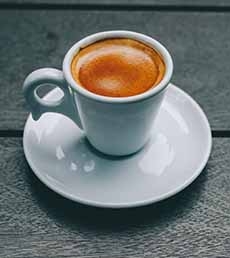
Espresso with a thick crema (photo © Victor Freitas | Pexels). |
Continue To Next Page, Terms D & E
Return to Article Index Above
Lifestyle Direct, Inc. All rights reserved. Images are the copyright of their respective owners.

|